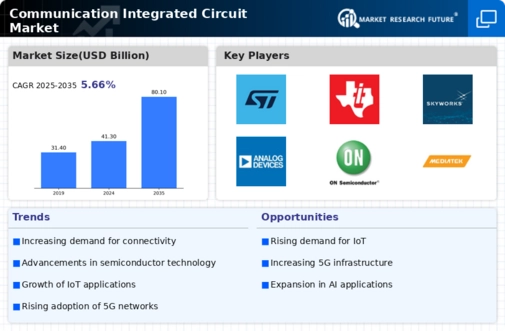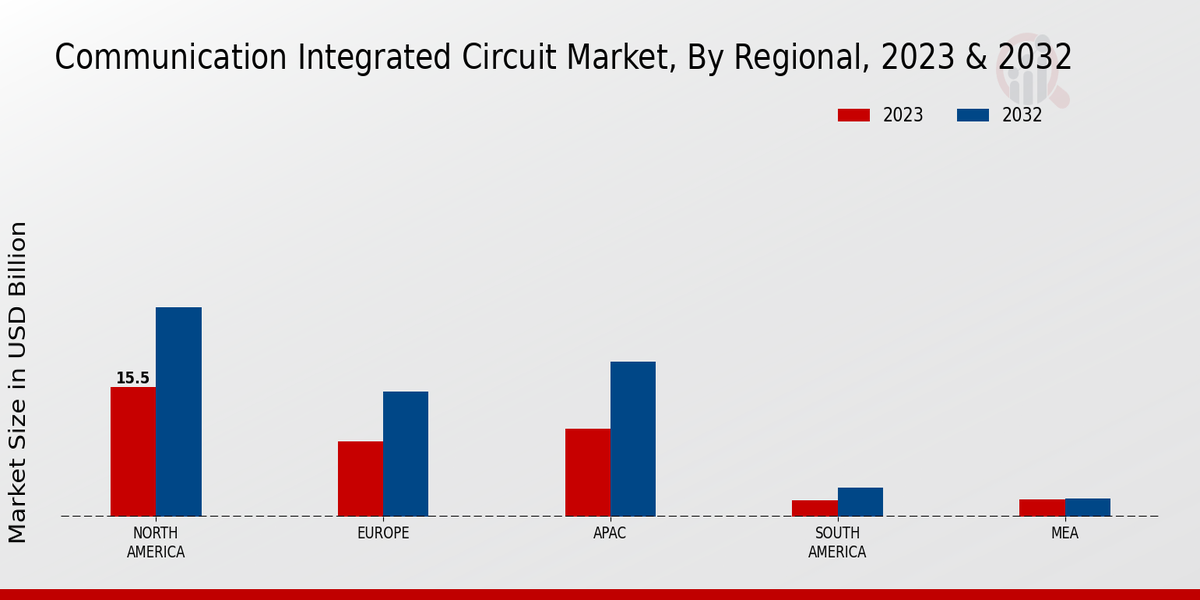Market Growth Projections
The Global Communication Integrated Circuit Market Industry is projected to experience substantial growth over the next decade. With a market value of 41.3 USD Billion in 2024, it is anticipated to reach 80.1 USD Billion by 2035. This growth trajectory suggests a compound annual growth rate (CAGR) of 6.2% from 2025 to 2035. Such projections indicate a robust demand for communication integrated circuits driven by advancements in technology, increasing connectivity needs, and the proliferation of smart devices. The market's expansion reflects the critical role of communication ICs in supporting modern communication systems.
Growth of 5G Infrastructure
The rollout of 5G infrastructure significantly impacts the Global Communication Integrated Circuit Market Industry. As countries invest heavily in 5G networks, the demand for communication integrated circuits that support these advanced technologies escalates. 5G promises enhanced data speeds, lower latency, and improved connectivity, which necessitates the use of sophisticated ICs. This trend is expected to drive the market's compound annual growth rate (CAGR) to 6.2% from 2025 to 2035. The integration of communication ICs into 5G infrastructure is crucial for enabling a wide range of applications, including autonomous vehicles and smart cities.
Emerging Markets and Urbanization
Emerging markets and urbanization contribute to the expansion of the Global Communication Integrated Circuit Market Industry. Rapid urbanization in developing regions leads to increased demand for communication infrastructure, including integrated circuits that support various applications. As urban populations grow, the need for reliable communication systems becomes paramount. This trend is particularly evident in regions such as Asia-Pacific, where urban centers are expanding rapidly. The influx of investments in communication technologies in these areas is likely to drive market growth, creating opportunities for manufacturers and stakeholders in the communication IC sector.
Increased Adoption of IoT Devices
The increasing adoption of IoT devices is a significant driver for the Global Communication Integrated Circuit Market Industry. As more industries and consumers embrace IoT technology, the demand for communication integrated circuits that facilitate connectivity and data exchange rises. These ICs are integral to the functioning of smart devices, ranging from industrial sensors to consumer electronics. The market's growth is further supported by the need for efficient data processing and transmission capabilities in IoT applications. This trend indicates a promising future for the market, with projections suggesting a substantial increase in revenue by 2035.
Advancements in Semiconductor Technology
Advancements in semiconductor technology play a pivotal role in shaping the Global Communication Integrated Circuit Market Industry. Innovations such as smaller, more efficient transistors and improved fabrication techniques contribute to the development of high-performance integrated circuits. These advancements enable manufacturers to produce communication ICs that are not only faster but also consume less power. As a result, the market is poised for growth, with projections indicating a rise to 80.1 USD Billion by 2035. The continuous evolution of semiconductor technology is essential for meeting the increasing demands of modern communication systems.
Rising Demand for Wireless Communication
The Global Communication Integrated Circuit Market Industry experiences a notable surge in demand for wireless communication technologies. As the world becomes increasingly interconnected, the need for efficient and reliable wireless communication systems grows. This trend is driven by the proliferation of smartphones, IoT devices, and smart home technologies. In 2024, the market is projected to reach 41.3 USD Billion, reflecting a robust growth trajectory. The integration of advanced communication integrated circuits in these devices enhances connectivity and data transmission speeds, thereby supporting the expansion of wireless networks globally.
















